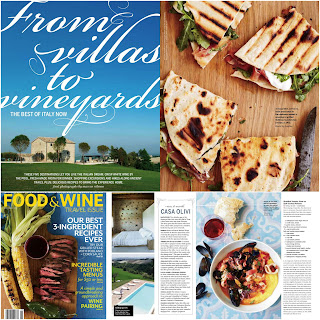Every European nation has been attributed its own clichés: The
French complain a lot but are romantic, the Germans have no sense
of humor but work very hard, The Spanish are loud but welcoming,
etc. You will agree I think that an entire nation cannot be
cataloged into such narrow boxes. I happen to live in Germany and
most people I have encountered do have a sense of humor. They are
also in the vast majority very helpful, warm and welcoming towards
my family and myself.
One cliché I do find to be true, though, is how important body language is to Italians. Perhaps I especially notice it as it has been pointed out to me that I am prone to "speaking with my hands". No doubt this is the Italian blood in me coming to the surface!
During a visit to the lesser known perhaps but absolutely gorgeous region of the Marches, we encountered many local people and enjoyed watching them interacting. Our house was close to the lovely walled city of Urbino, to which we cycled on a magnificent sunny day. Comfortably sitting down at a café terrace and having ordered much needed refreshments, I began to discreetly look at our neighbors. Now my Italian is rather basic, and I did not try, nor did I want, to pry. I just observed people instead.
Two women in their mid-thirties, I would say, we engrossed in a passionate and obviously very amusing discussion. They both kept throwing their heads back, laughing heartily, hands alternatively flying to their mouths and to their hearts. Their eyes were twinkling, and they were having trouble keeping the loudness of their voices under control. Behind them I spotted a woman with two young boys. The look of love in her eyes, her head half tilted, the way she kept patting their heads and pinching their round cheeks, all this told me that she was their mother. She had a game of blowing them kisses, pulling a funny face at the same time, which kept the little ones highly entertained. On the other side, a middle age couple look as though they were going through a stormy patch in their relationship. Hands were pointing accusingly at each other, and it seemed that reproaches were being uttered through clenched teeth. After a while, they both sat back and fell silent, looking away from each other, arms firmly crossed on their chests. Finally, I rested my gaze on a group of teenagers, the girls pretending not to be flirting while the boys clearly were competing for their attention. They kept getting up, throwing their arms on the side, and looking deeply into the eyes of the girl they were desperate to impress. In return the said girl usually gave a small smile and intense look, only to quickly resume her demure position.
As they walked away, I noticed hands being held and heads resting on shoulders. I could not help but smile: the courting had clearly been successful!
One cliché I do find to be true, though, is how important body language is to Italians. Perhaps I especially notice it as it has been pointed out to me that I am prone to "speaking with my hands". No doubt this is the Italian blood in me coming to the surface!
During a visit to the lesser known perhaps but absolutely gorgeous region of the Marches, we encountered many local people and enjoyed watching them interacting. Our house was close to the lovely walled city of Urbino, to which we cycled on a magnificent sunny day. Comfortably sitting down at a café terrace and having ordered much needed refreshments, I began to discreetly look at our neighbors. Now my Italian is rather basic, and I did not try, nor did I want, to pry. I just observed people instead.
Two women in their mid-thirties, I would say, we engrossed in a passionate and obviously very amusing discussion. They both kept throwing their heads back, laughing heartily, hands alternatively flying to their mouths and to their hearts. Their eyes were twinkling, and they were having trouble keeping the loudness of their voices under control. Behind them I spotted a woman with two young boys. The look of love in her eyes, her head half tilted, the way she kept patting their heads and pinching their round cheeks, all this told me that she was their mother. She had a game of blowing them kisses, pulling a funny face at the same time, which kept the little ones highly entertained. On the other side, a middle age couple look as though they were going through a stormy patch in their relationship. Hands were pointing accusingly at each other, and it seemed that reproaches were being uttered through clenched teeth. After a while, they both sat back and fell silent, looking away from each other, arms firmly crossed on their chests. Finally, I rested my gaze on a group of teenagers, the girls pretending not to be flirting while the boys clearly were competing for their attention. They kept getting up, throwing their arms on the side, and looking deeply into the eyes of the girl they were desperate to impress. In return the said girl usually gave a small smile and intense look, only to quickly resume her demure position.
As they walked away, I noticed hands being held and heads resting on shoulders. I could not help but smile: the courting had clearly been successful!












